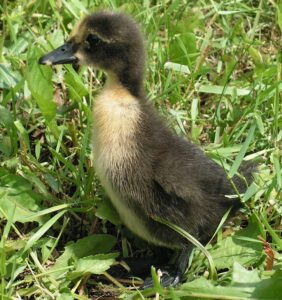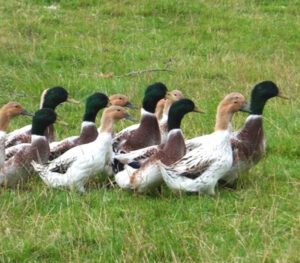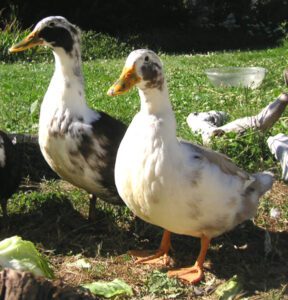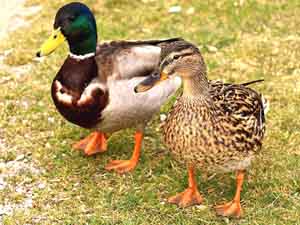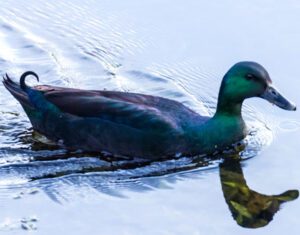The Silver Appleyard duck is a breed of domestic duck developed in the 1940s. It was developed by Reginald Appleyard at his famous Priory Waterfowl Farm near Bury St. Edmund, England.
And not surprisingly, the breed is named after Reginald Appleyard as he developed the breed. He was willing to create a very attractive large duck breed that would also be a prolific producer of large, white eggs.
The Silver Appleyard duck is also known as the Large Appleyard. And the miniature version of this duck breed is called the Miniature Appleyard, which was developed by Tom Bartlett of Folly Farm in the 1980s.
The breed is actually based on a cross between the large breeds of Rouen, Pekin and Aylesbury.
Silver Appleyard duck became very rare after the Second World War, as the interest in poultry declined in Britain. The breed was introduced to the United States in the 1960s.
But it didn’t become available to the public until 1984. The breed was admitted into the American Poultry Association’s Standard of Perfection in 2000, and to the British Poultry Standard in 1982.
Silver Appleyard duck is pretty rare in the United States today. And the American Livestock Breeds Conservancy lists this breed as ‘Threatened’ on it’s Conservation Priority List. But the breed may be more common in the United Kingdom.
Silver Appleyard Duck
Silver Appleyard duck is classed as a heavy duck breed. It is a very beautiful dual purpose duck suitable for both meat and eggs production. In appearance, it is a large and sturdily built duck breed.
The carriage of the Silver Appleyard ducks varies from 15 to 25 degrees above horizontal and their body has a ‘blocky’ conformation. The bill of the drakes is greenish or yellow with a black tip. Their eyes are brown and head and neck are greenish-black (sometimes exhibiting striping with age).
The breast, flank, shoulders and sides on a drake are reddish-chestnut with white frosting and lacing. Their legs and feet are orange and the tail is blackish bronze. The underbody of the Silver Appleyard drake is creamy or silvery white and the wings are gray and white with bright blue cross-stripe.
On the other hand, female Silver Appleyards have yellow or orange bill with a black bean, and their eyes are brown. Their legs and feet are orange in color with dark toenails. The plumage of the females is usually whitish with gray, brown, fawn and buff markings.
There is a blue cross-stripe on their wings. Like most other domestic duck breeds, the Silver Appleyard ducks are pretty lighter than the drakes. On average, the drakes weight about 3.6 to 4.1 kg and the ducks weight about 3.2 to 3.6 kg.
History
Silver Appleyard ducks were developed in the mid-twentieth century by Reginald Appleyard, a British poultry breeder who aimed to create a large, dual-purpose duck that was both aesthetically pleasing and productive.
Appleyard drew inspiration from the Khaki Campbell, a popular breed of duck at the time, but set out to create a bird with more weight, greater egg production, and a striking plumage pattern.
By crossing a number of different breeds, including Rouen, Pekin, and Aylesbury ducks, Appleyard successfully bred a new type of duck that combined the desired traits of size, color, and productivity.
The breed gained popularity quickly, particularly in the United Kingdom and the United States, where they are still commonly kept today.
Physical Appearance
One of the most distinctive features of the Silver Appleyard duck is its feather coloring. Adult birds have an iridescent green head and neck, with white rings around their necks and black spots on their bills.
Their bodies are a warm, chestnut brown color, with silver-gray wings and backs. Males and females are similar in appearance, though males tend to be slightly larger and more brightly colored than females.
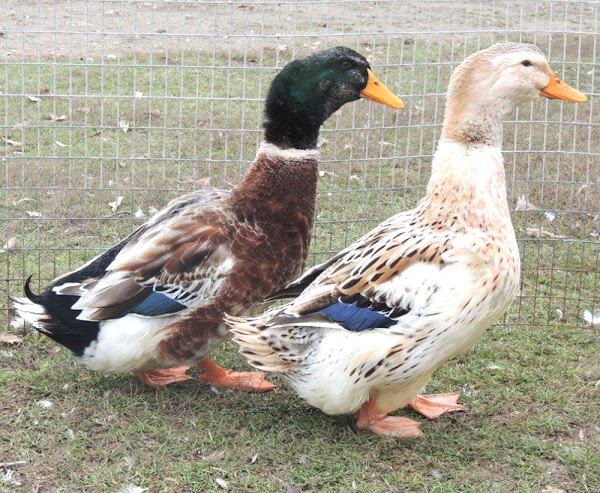
In terms of size, Silver Appleyards are considered a large breed of duck, with adult birds weighing between 7 and 9 pounds. They have a broad, rounded body shape and a slightly upturned tail.
Their legs are orange or yellow in color and relatively short, making them less adept at flying than some other breeds.
Behavior
Silver Appleyard ducks are known for their friendly and sociable personalities. They enjoy the company of humans and other ducks, and will often follow their owners around the yard or garden.
They are also relatively calm and docile, making them a good choice for families with children or novice duck keepers.
In terms of activity level, Silver Appleyards are fairly active birds that enjoy foraging, swimming, and exploring their surroundings. They require access to water in order to stay healthy and happy, as they use it both for drinking and bathing.
They are also hardy birds that can tolerate a range of weather conditions, though they may require additional shelter or heating during particularly cold or wet periods.
Diet
Silver Appleyard ducks are omnivores that eat a varied diet of both plant and animal matter. In the wild, they would typically feed on aquatic plants, insects, snails, and small fish or amphibians.
In captivity, they can be fed a commercial duck feed that is formulated to meet their nutritional needs, along with fresh vegetables, fruits, and grains.
It is important to ensure that ducks have access to clean, fresh water at all times, as they need it both for drinking and bathing. Be sure to provide a shallow pool or pond that is large enough for your ducks to swim in comfortably, but not so deep that they cannot touch the bottom.
Habitat
Silver Appleyard ducks are adaptable birds that can thrive in a variety of environments. They can be kept in backyard gardens, rural farms, or suburban homesteads, as long as they have access to a suitable living space and adequate food and water.
When housing Silver Appleyard ducks, it is important to provide them with a secure and spacious coop or shelter that is protected from predators, such as foxes or raccoons.
The coop should be well-ventilated and equipped with nesting boxes and perches, as ducks enjoy roosting off the ground.
Breeding
Silver Appleyard ducks are prolific layers that can produce up to 250 large, white eggs per year. They typically begin laying in their first year of life and will continue to lay for several years thereafter.
Eggs can be incubated naturally or using an artificial incubator, and hatch after a period of around 28 days.
When breeding Silver Appleyards, it is important to select healthy, genetically diverse birds with desirable traits such as size, color, and temperament.
Males should be used sparingly to avoid excessive inbreeding, which can lead to health problems and reduced productivity.
Uses
The Silver Appleyard duck was developed as an utility bird. It is suitable for both meat and eggs production.
Special Notes
Silver Appleyard ducks are suitable for all purposes. They are being raised for decoration, exhibition, as pets, eggs and gourmet roasting ducks. They are not among the best egg laying duck breeds, but they lay a good amount of large white eggs. And they are considered as best layers among the heavyweight ducks.
Ducks usually lay about 250 eggs per year and often go broody. Silver Appleyard duck is active forager and generally have calm temperaments. They tend to stay close to home if well fed. The breed is also a very good meat duck breed and suitable for quality meat production. Their meat is lean and flavorful.
The drakes are quick to mature and by 9 weeks of age can reach about 3 kg. The Silver Appleyard duck is quiet in nature and well suited to being kept at home as pets. Review full breed profile of the Silver Appleyard duck in the chart below.
| Breed Name | Silver Appleyard |
| Other Name | Large Appleyard, the miniature version is called Miniature Appleyard |
| Breed Purpose | Dual Purpose (eggs & meat) |
| Special Notes | Active, Calm, Friendly, Docile, Fast Grower |
| Breed Class | Heavy |
| Broodiness | Average |
| Ducks | 3.2 to 3.6 kg |
| Drakes | 3.6 to 4.1 kg |
| Climate Tolerance | All Climates |
| Egg Color | White |
| Egg Size | Large |
| Egg Weight | 80-95 grams |
| Egg Productivity | Medium |
| Flying Ability | Poor |
| Rarity | Common |
| Varieties | Silver |
| Country of Origin | United Kingdom |
Interesting Facts About Silver Appleyard Ducks
Silver Appleyard ducks are a fascinating breed of domestic duck that are known for their unique feather coloring, friendly temperament, and productive egg-laying capabilities.
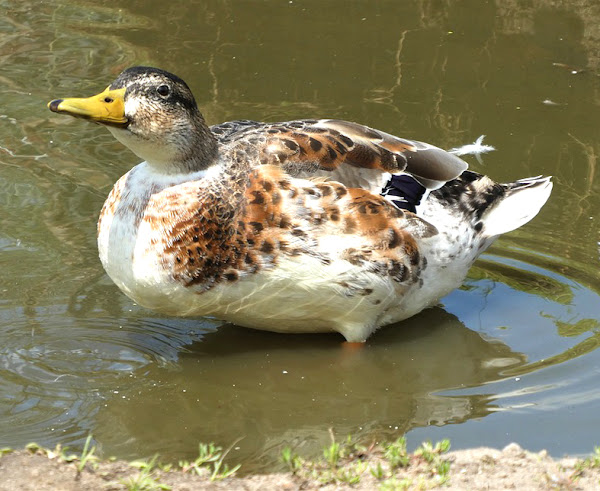
Here are some interesting facts about Silver Appleyard ducks, from their history and physical characteristics to their behavior, diet, habitat, and breeding.
- Silver Appleyard ducks were developed in the mid-twentieth century by the British poultry breeder Reginald Appleyard, who aimed to create a large, dual-purpose duck that was both aesthetically pleasing and productive.
- Appleyard drew inspiration from several different breeds, including Rouen, Pekin, and Aylesbury ducks, which he crossed to create the new breed.
- The first Silver Appleyard ducks were exhibited at the London Dairy Show in 1947, where they quickly gained popularity among poultry enthusiasts.
- Silver Appleyard ducks are named for their creator, Reginald Appleyard, and their distinctive silver-gray feather coloration.
- Adult Silver Appleyard ducks weigh between 7 and 9 pounds, making them a large breed of duck.
- One of the most distinctive features of Silver Appleyard ducks is their feather coloring. Adult birds have an iridescent green head and neck, with white rings around their necks and black spots on their bills. Their bodies are a warm, chestnut brown color, with silver-gray wings and backs.
- Males and females are similar in appearance, though males tend to be slightly larger and more brightly colored than females.
- Silver Appleyard ducks are known for their friendly and sociable personalities. They enjoy the company of humans and other ducks, and will often follow their owners around the yard or garden.
- In terms of activity level, Silver Appleyards are fairly active birds that enjoy foraging, swimming, and exploring their surroundings.
- Silver Appleyard ducks require access to water in order to stay healthy and happy, as they use it both for drinking and bathing. They are also hardy birds that can tolerate a range of weather conditions, though they may require additional shelter or heating during particularly cold or wet periods.
- Silver Appleyard ducks are omnivores that eat a varied diet of both plant and animal matter. In the wild, they would typically feed on aquatic plants, insects, snails, and small fish or amphibians.
- In captivity, Silver Appleyard ducks can be fed a commercial duck feed that is formulated to meet their nutritional needs, along with fresh vegetables, fruits, and grains.
- It is important to ensure that ducks have access to clean, fresh water at all times, as they need it both for drinking and bathing.
- Silver Appleyard ducks are adaptable birds that can thrive in a variety of environments. They can be kept in backyard gardens, rural farms, or suburban homesteads, as long as they have access to a suitable living space and adequate food and water.
- When housing Silver Appleyard ducks, it is important to provide them with a secure and spacious coop or shelter that is protected from predators, such as foxes or raccoons.
- The coop should be well-ventilated and equipped with nesting boxes and perches, as ducks enjoy roosting off the ground.
- Silver Appleyard ducks are prolific layers that can produce up to 250 large, white eggs per year.
- They typically begin laying in their first year of life and will continue to lay for several years thereafter.
- Eggs can be incubated naturally or using an artificial incubator, and hatch after a period of around 28 days.
- When breeding Silver Appleyards, it is important to select healthy, genetically diverse birds with desirable traits such as size, color, and temperament.
- Males should be used sparingly to avoid excessive inbreeding, which can lead to health problems and reduced productivity.
- In addition to their productive egg-laying capabilities and attractive appearance, Silver Appleyard ducks are also known for their gentle personalities and easygoing nature, making them a popular choice among backyard poultry keepers and homesteaders.
Tips for Raising Silver Appleyard Ducks
Raising Silver Appleyard ducks can be very easy and simple, but it requires careful planning and attention to detail. Here we are going to share some important tips for raising Silver Appleyard ducks successfully, from selecting healthy birds and providing appropriate housing to feeding them a balanced diet and ensuring they have access to clean water.
Choose healthy birds
When selecting Silver Appleyard ducks for your flock, choose birds that are active, alert, and free from any visible signs of illness or injury. Check their eyes, nostrils, and feathers for any signs of discharge or abnormality.
Start with a small flock
If you are new to duck keeping, start with a small flock of two to four birds to get a feel for what is involved.
Provide appropriate housing
Silver Appleyard ducks require a spacious and secure coop or shelter that is protected from predators, such as foxes or raccoons. The coop should be well-ventilated and equipped with nesting boxes and perches, as ducks enjoy roosting off the ground.
Install a predator-proof fence
To protect your ducks from predators, install a sturdy fence around their enclosure that extends at least a foot underground to prevent animals from digging their way in.
Provide plenty of space
Silver Appleyard ducks need plenty of space to move around and exercise. Provide at least 10 square feet of space per bird in their enclosure.
Offer a shallow pool or pond
Ducks need access to water for drinking and bathing. Provide a shallow pool or pond that is large enough for your ducks to swim in comfortably, but not so deep that they cannot touch the bottom.
Monitor water quality
Regularly check the quality of the water in your ducks’ pool or pond, and change it frequently to keep it clean and fresh.
Feed a balanced diet
Silver Appleyard ducks require a balanced diet that provides them with the nutrients they need to stay healthy and productive. Feed them a commercial duck feed that is formulated to meet their nutritional needs, along with fresh vegetables, fruits, and grains.
Supplement with protein
Ducks also need plenty of protein in their diet for healthy growth and egg production. Offer them protein-rich treats such as mealworms, crickets, or chopped hard-boiled eggs.
Provide grit
Ducks need grit in their diet to help them digest food properly. Offer them a small amount of coarse sand or crushed oyster shells to help grind up their food.
Avoid overfeeding
Overfeeding can lead to obesity and health problems in ducks. Monitor your ducks’ weight and adjust their feeding schedule accordingly.
Check for parasites
Regularly check your ducks for signs of parasites such as mites or lice. Treat infestations promptly to prevent them from spreading to other birds.
Keep the coop clean
Clean the coop or shelter at least once a week to prevent the buildup of waste and bacteria. Replace bedding frequently to keep it dry and odor-free.
Maintain good ventilation
Good ventilation is essential to prevent the buildup of ammonia from the ducks’ waste. Install vents or windows in the coop to promote air circulation.
Provide shade
Ducks can suffer from heat stress in hot weather. Provide shade in their enclosure to help keep them cool.
Protect against cold weather
Silver Appleyard ducks can tolerate cold temperatures, but they may require additional shelter or heating during particularly cold or wet periods.
Provide nesting boxes
Ducks need nesting boxes to lay their eggs in. Provide one nesting box per three to four birds, filled with clean straw or shavings.
Collect eggs regularly
Collect eggs at least once a day to prevent them from becoming dirty or damaged. Store them in a cool, dry place until you are ready to use them.
Monitor for signs of illness
Regularly monitor your ducks for signs of illness or injury, such as lethargy, loss of appetite, or abnormal behavior. Seek veterinary care if necessary.
Keep a first aid kit on hand
Keep a first aid kit on hand in case of emergencies, including bandages, antiseptic, and other essential supplies.
Practice biosecurity
Practice good biosecurity measures to prevent the spread of disease. Avoid sharing equipment or supplies with other poultry keepers, and wash your hands thoroughly before and after handling your ducks.
Enjoy your ducks
Finally, don’t forget to enjoy your Silver Appleyard ducks! They are fascinating birds that offer plenty of entertainment and joy to their owners. Spend time observing their behavior and personalities, and appreciate the unique bond you share with them.

